Neil, as a practical matter, if you are shooting “standard” subjects under “ordinary” conditions and have chosen the right camera settings, both RAW and JPG probably will deliver a high percentage of shots that come in acceptable color, brightness, contrast, etc., right out of the camera. Those shots will require little post-processing either in Camera Raw or Photoshop to tweak them into shape for ordinary uses – sharing with friends, posting on the internet, etc.
RAW is useful when shooting conditions – lighting, especially – get “tricky.” Sunrise and sunset can produce stunningly beautiful but difficult light conditions that may baffle the camera’s processing capability, meaning RAW format is the way to go if you want to preserve your widest range of options. Another tricky condition might be deep shade, as in hiking through an area with dense forest canopy. Mixed light – say, natural daylight or firelight and flash --can be “tricky,” too.
I personally find RAW to be very useful when doing theatrical or nightclub performance photography (where the lighting can be outright bizarre), and night sports (where the lighting can be plain old disgusting). In fact, RAW has become my default image format setting because it helps with the oddball stuff but also does a great job on the more ordinary. I do not use the RAW + JPG option.
As I understand it (and this may or may not be the way it really is) the difference between shooting in RAW and one of the JPG formats is:
- In RAW, all data coming through the digital camera sensor in accord with the camera control settings (like white balance) are saved to the image file. This yields (relatively) large image files.
- In JPG, the captured RAW data are processed in and by the camera to some optimized standard correlated with camera settings like white balance, b rightness and contrast. Some data are discarded in the conversion to JPG, yielding (relatively) smaller image files.
- When you open the image in PS Camera RAW or an equivalent program, you can manually optimize the image to suit your sense of what the scene looked like (or the image of it should look like). You can adjust color temperature, overall tint, white balance, exposure, shadow brightness, highlight brightness, contrast, etc., in the image to suit your taste. Some of these adjustments can be astonishingly large when needed.
- By comparison, when you open a JPG image in Photoshop, the adjustments you can make are considerably more limited in range.
G.



